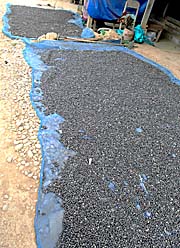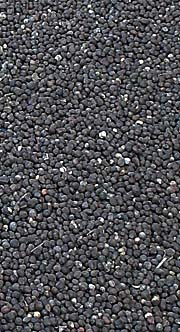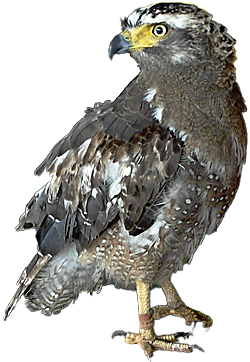A high Plain in south Laos
Coming from Pakse following the national road 13, a few kilometers later the 16, it's steadily going upwards. While Pakse is a hot place at the banks of the magnificent Mekong River, Bolaven is a high plain on an altitude of an average of 1,200m. That means a moderate, partially even cool climate. A rain shower in Paksong, 50km from Pakse, leads even in hot season to a severe drop of temperature.
Bolaven Plateau is a huge area, streching some 10,000km2 out through the mountains. It's origins date back to an ancient (super-) volcano who shaped this really unusually landscapes. The plateau is not densly inhabited by a number of hill tribes who belong mostly to the Mon/Khmer linguistic family. The largest tribe are the Laven, after them the plateau is named: 'Bo Laven', means 'home of the Laven'. Until recent years the hill people could still live in their old patterns, but now, in the time of rapid industrial development of whole Laos and particularly Pakse, they come more and more under the influence of the state and the lowland Laotians. That means they suffer similar deprivation patterns as the many tribal people in the north of Laos. Their culture get's vaporized for the sake of global capitalist lifestyle - for a part of the people that means an unconscious life in air-con offices, supermarkets, new family houses of lowest building quality and driving the notorious Japanese pickups, for the others, the most, it means a life in slums.
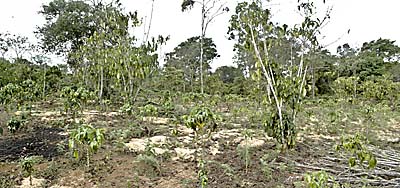
In a coffee plantation on Bolaven Plateau. The plantations still contain some big forest trees. Image by Asienreisender, 2013
Since the time of the French occupation modern agriculture for export is invented. Here it means mostly the cultivation of coffee (a typical colonial product), but also tea, pepper, rubber and cardamom. Even after the end of the French colonial time some French farmers remained staying here. They went finally out due to the heavy pattern bombing of the whole region by the American Air Force in the American Vietnam War (also: Second Indochina War). The main place of the Bolaven Plateau, Paksong, got completely destroyed due to American bomb attacks. That's why parts of the plateau are still contamined with UXO (unexploded ordnance).
That's sometimes even for the 'sake' of nature in long-term. UXO is hold responsible for a certain delay in the development of Laos. Considerable parts of the country, here the Bolaven Plateau, are not safe to go. And the removal of the UXO is immensely expensive, dangerous and time consuming. For that reason parts of the nature here remain untouched and are refuges for wildlife. It's said a few of Laos remaining tigers would life here. Hornbills, gibbons, eagles and a lot of other animals retreated into the remote parts of Bolaven Plateau.
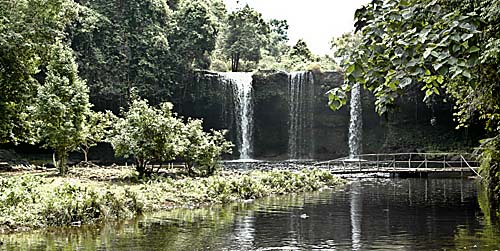
Tam Chan Pee, a waterfall a bit off the main tourist track. Surrounded by coffee plantations it's a quiet place to have a bath in the pool ahead. Image by Asienreisender, 2013
There is also a great number of waterfalls on Bolaven Plateau. Among them is Tad Fane Waterfall, the highest in Laos (a double waterfall, actually, a right turn at KM38 on road no. 16 from Pakse to Paksong). Anyway, as it is usually the case in Laos, far before you can see a waterfall you see a ticket booth. By a 1,000% probability there is somebody to cash you for entering and for parking a vehicle or for taking a vehicle inside. I guess soon they will start charging extra for cameras and food is then only allowed in the contract restaurant. Tad Fane Waterfall for example is overrun by mass touristm from Bangkok and other places from Thailand. Thai People love waterfalls. The biggest busses are frequently arriving and departing the small parking in front of the ticket booth.
Since there are so many waterfalls and the charging game is repeating again and again, it's not only ridiculous and annoying but also expensive when it adds up.
If you expect the benefiters of the entrance fees doing anything good for the surrounding you can forget it. The local people see no value in their natural surroundings except the generated income. They don't remove litter left by the tourists. If it get's too much, they just burn it, including all of the plastic.
